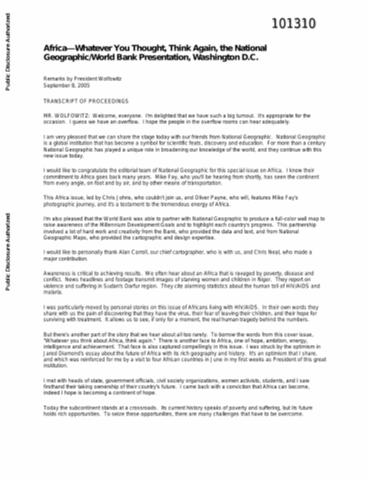The World Bank is a vital source of financial and technical assistance to developing countries around the world. We are not a bank in the ordinary sense but a unique partnership to reduce poverty and support development. The World Bank Group has two ambitious goals: End extreme poverty within a generation and boost shared prosperity.
- To end extreme poverty, the Bank's goal is to decrease the percentage of people living on less than $1.25 a day to no more than 3% by 2030.
- To promote shared prosperity, the goal is to promote income growth of the bottom 40% of the population in each country.
The World Bank Group comprises five institutions managed by their member countries.
The World Bank Group and Land: Working to protect the rights of existing land users and to help secure benefits for smallholder farmers
The World Bank (IBRD and IDA) interacts primarily with governments to increase agricultural productivity, strengthen land tenure policies and improve land governance. More than 90% of the World Bank’s agriculture portfolio focuses on the productivity and access to markets by small holder farmers. Ten percent of our projects focus on the governance of land tenure.
Similarly, investments by the International Finance Corporation (IFC), the World Bank Group’s private sector arm, including those in larger scale enterprises, overwhelmingly support smallholder farmers through improved access to finance, inputs and markets, and as direct suppliers. IFC invests in environmentally and socially sustainable private enterprises in all parts of the value chain (inputs such as irrigation and fertilizers, primary production, processing, transport and storage, traders, and risk management facilities including weather/crop insurance, warehouse financing, etc
For more information, visit the World Bank Group and land and food security (https://www.worldbank.org/en/topic/agriculture/brief/land-and-food-security1
Resources
Displaying 4816 - 4820 of 4907Africa
Paul Wolfowitz, President of the World Bank, congratulated the editorial team of National Geographic for the special issue on Africa. National Geographic has played a unique role in broadening the knowledge of the world. The World Bank partnered with National Geographic to produce a full-color wall map to raise awareness of the millennium development goals (MDGs) and to highlight each country's progress. We often hear about an Africa that is ravaged by poverty, disease and conflict. There is another face to Africa, one of hope, ambition, energy, intelligence and achievement.
Notes on the Economic Evaluation of Transport Projects
In response to many requests for help in the application of both conventional cost benefit analysis in transport and addressing of the newer topics of interest, we have prepared a series of Economic Evaluation Notes that provide guidance on some of issues that have proven more difficult to deal with. The Economic Evaluation Notes are arranged in three groups.
Poverty in Guatemala
Poverty in Guatemala is high and deep. In 2000, over half of all Guatemalans lived in poverty. About 16 percent lived in extreme poverty. Available evidence suggests that poverty in Guatemala is higher than in other Central American countries. Although poverty has fallen over the past decade, its trend recently declined due to a series of economic shocks during 2001 and 2002. The drop of poverty incidence since 1990 is slightly slower than what would have been predicted given Guatemala's growth rates, suggesting that growth has not been particularly pro-poor.
Thailand’s 20 year program to title rural land (draft)
In 1982 the population of Thailand was about 48 million and there was increasing pressure on land resources. This paper describes how the Department of Lands designed and implemented a 20 year Land Titling Program (LTP) to grant secure tenure to agricultural landholders. The success of the land-titling program in Thailand has been due to a number of factors. A major factor has been the clear vision for the project, the long-term plan to achieve this vision and the commitment of RTG and the key stakeholders to project implementation.
Colombia : Land Policy in Transition
Only 30 percent of land suitable for agriculture is utilized for crops (with significant regional variation). More than double the area suitable for pasture is used for livestock grazing, with negative environmental consequences. Although markets provide land access to poor and productive producers, they are not effective in transferring land from large to small producers, implying continuing concentration, driven largely by violence and displacement.










